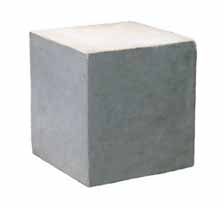The Ashlars
- Details
- Written by Robert Taylor
Do you know what ashlars are? Look at the photos of ashlars from lodge rooms 2, 3, 4 & 5 at the Sydney Masonic Centre. They are not all cubes, although most, if not all, ashlars outside Grand Lodge are. The question is, should they be cubes?

 The rough ashlar is an axe-trimmed, roughly squared stone as taken from the quarry that approximates the shape of the stone that is needed. To us, as Speculative masons, it represents the new Mason: good quality material that has been closely examined and accepted, but still needs the rough edges removed and a polish applied.
The rough ashlar is an axe-trimmed, roughly squared stone as taken from the quarry that approximates the shape of the stone that is needed. To us, as Speculative masons, it represents the new Mason: good quality material that has been closely examined and accepted, but still needs the rough edges removed and a polish applied.
The perfect ashlar is the ultimate stone, perfect in all its parts, its angles and finish. To us it represents the goal of our life, our striving for perfection. Note that the rough ashlar already contains the perfect ashlar within it but an artist is needed to extract it – to remove the knobs and excrescences, and to achieve the desired degree of finish that only education and self discipline can achieve.
Every mason is working on his ashlar – call it his Master's piece if you will – striving to attain the degree of perfection needed, removing his passions and prejudices along the way. Paradoxically, every mason is both the material and the builder and, ultimately, the High Priest in the Temple that he has created. It is in that Temple that he returns to God. We all seek for that which was lost, the direct interface with God, lost when mankind was expelled from the Garden of Eden.
Is any ashlar truly perfect? Does any mason ever truly attain perfection? In the loneliness of his own mind each man must face that question and truthfully and hon- estly face the reality before he is judged on high. Even if perfection is not attain- able we should never stop striving for it, always trying to improve. No wall ever made was composed of perfect stones, but still they stand as a monument to the builder and an inspiration for future generations. The imperfections of one stone are balanced by the imperfections of another and evened out.
In some jurisdictions the rough ashlar is placed in front of the Junior Warden, or on his pedestal, to represent work at high-noon, or, if you will, work-in- progress. Similarly the perfect ashlar is placed in front of the Senior Warden, or on his pedestal, to represent the work at the close of day, that is, finished or ended and ready for presentation.
Before the advent of the printed bible, it had been said that the operatives had their candidates kneel on a rough ashlar when taking their obligation and placing their hand on the perfect ashlar, the symbol of perfection. Thus it can be seen that the ash- lars were always meaningful to masons and were used for moralising upon.
On the question of cubes, one should remember that few, if any, walls are actu- ally made from cubical stones but that should not diminish our interest in their moral application. Actually, in former times, a ‘perpend’ ashlar was used to bind the fabric of a wall together. This was a squared stone but its three dimensions were all different. The stone was laid with its thin dimension uppermost or perpen- dicular, hence ‘perpend’. It no longer features in our ceremonial or moralising which was a regret to Bernard Jones as the aspect of working with and binding the other stones together is now ignored.
When next you enter a lodge room and take your seat, consider the ashlars. Mark the work that has gone into them and consider the work you need to do. Think of the tools that have been applied to each and consider that each and every working tool has been utilised to achieve the finished stone from the planning and design stage to the final application of smoothing and then the actual measurement and proving of its perfection.
The message from this is that from start to finish, we need the full range of tools if we are to be the stone of perfection, for it to take its place in our Temple. We need to employ them all, if not physically, then morally.
Article extracted from Freemason magazine, Winter 2012, page 28.


